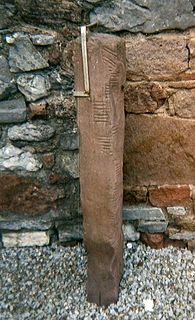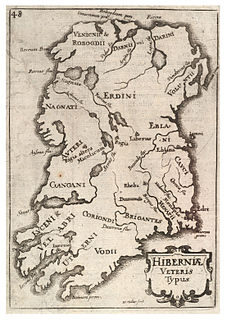
The Picts were a confederation of peoples who lived in what is today eastern and northern Scotland during the Late Iron Age and Early Medieval periods. Where they lived and what their culture was like can be inferred from the geographical distribution of Brittonic place name elements and Pictish stones. The name Picts appears in written records from Late Antiquity to the 10th century, when they are thought to have merged with the Gaels. They lived to the north of the rivers Forth and Clyde, and spoke the Pictish language, which was closely related to the Celtic Brittonic language spoken by the Britons who lived to the south of them.

The Corpus JurisCivilis is the modern name for a collection of fundamental works in jurisprudence, issued from 529 to 534 by order of Justinian I, Eastern Roman Emperor. It is also sometimes referred to as the Code of Justinian, although this name belongs more properly to the part titled Codex Justinianus.

In medieval Gaelic and British culture, a bard was a professional story teller, verse-maker, music composer, oral historian and genealogist, employed by a patron, to commemorate one or more of the patron's ancestors and to praise the patron's own activities.

Early Irish law, also called Brehon law, comprised the statutes which governed everyday life in Early Medieval Ireland. They were partially eclipsed by the Norman invasion of 1169, but underwent a resurgence from the 13th until the 17th centuries, over the majority of the island, and survived into Early Modern Ireland in parallel with English law. Early Irish law was often, although not universally, referred to within the law texts as Fenechas, the law of the Feni or free men of Gaelic Ireland mixed with Christian influence and juristic innovation. These secular laws existed in parallel, and occasionally in conflict, with canon law throughout the early Christian period.

Ogham is an Early Medieval alphabet used to write the early Irish language, and later the Old Irish language. There are roughly 400 surviving orthodox inscriptions on stone monuments throughout Ireland and western Britain; the bulk of which are in southern Munster. The largest number outside Ireland are in Pembrokeshire, Wales.
A number of law codes have in the past been in use in the various Celtic nations since the Middle Ages. While these vary considerably in details, there are certain points of similarity.
Middle Irish is the Goidelic language which was spoken in Ireland, most of Scotland and the Isle of Man from circa 900-1200 AD; it is therefore a contemporary of late Old English and early Middle English. The modern Goidelic languages—Irish, Scottish Gaelic and Manx—are all descendants of Middle Irish.
Godred Crovan, known in Gaelic as Gofraid Crobán, Gofraid Meránach, and Gofraid Méránach, was a Norse-Gaelic ruler of the kingdoms of Dublin and the Isles. Although his precise parentage is uncertain, he was very likely an Uí Ímair dynast, and probably a descendant of Amlaíb Cúarán, King of Northumbria and Dublin.
A number of Irish annals, of which the earliest was the Chronicle of Ireland, were compiled up to and shortly after the end of the 17th century.
Seven Nations is a Celtic rock band that formed in New York City in 1993. The name comes from the seven Celtic nations, including Scotland, Ireland, Wales, Brittany, Cornwall, the Isle of Man, and Galicia. The band tours extensively and has played in many diverse venues, from small bars to concert halls. They were previously known as Clan Na Gael, but lost that name due to a trademark dispute. At just that time, they got a huge sponsor, allowing them expanded notoriety.

Thomas Mowbray Charles-Edwards is an emeritus academic at Oxford University. He formerly held the post of Jesus Professor of Celtic and is a Professorial Fellow at Jesus College.
Bretha Nemed Déidenach is the late title of an Early Irish law text dating from the eighth century.

Daniel Anthony Binchy (1899–1989) was a scholar of Irish linguistics and Early Irish law.
Oxford, Bodleian Library, Rawlinson B 502 is a medieval Irish manuscript which presently resides in the Bodleian Library, Oxford. It ranks as one of the three major surviving Irish manuscripts to have been produced in pre-Norman Ireland, the two other works being the Lebor na hUidre and the Book of Leinster. Some scholars have also called it the Book of Glendalough, in Irish Lebar Glinne Dá Locha, after several allusions in medieval and early modern sources to a manuscript of that name. However, there is currently no agreement as to whether Rawlinson B 502, more precisely its second part, is to be identified as the manuscript referred to by that title.
Uraicecht Becc is an Old Irish legal tract on status. Of all status tracts, it has the greatest breadth in coverage, including not only commoners, kings, churchmen and poets, but also a variety of other professional groups, including judges. However, it does not go into as much detail for each group and level as do other status tracts. T.M. Charles-Edwards suggests that it is "almost certainly of Munster origin", as it asserts the supremacy of the king of Munster above other Irish kings and makes reference to the monasteries of Emly and Cork.
Dubthach maccu Lugair, is a legendary Irish poet and lawyer who supposedly lived at the time of St Patrick's mission in Ireland and in the reign of Lóegaire mac Néill, high-king of Ireland, to which Dubthach served as Chief Poet and Brehon. In contrast to the king and his druids, he is said to have readily accepted the new religion. This event has played a major part in Hiberno-Latin and Irish sources as representing the integration of native Irish learning with the Christian faith.
The Ciarraighe Locha na nÁirne were a branch of the Ciarraighe people, located in what is now central-east County Mayo in Connacht.
An Irish Astronomical Tract, medieval Irish text and manuscript.
The Institutes of Justinian is a unit of the Corpus Juris Civilis, the sixth century codification of Roman law ordered by the Byzantine emperor Justinian I. It is largely based upon the Institutes of Gaius, a Roman jurist of the second century A.D. The other units in the Corpus Juris Civilis are the Digest, the Codex Justinianus, and the Novellae Constitutiones.

Dunum was a Latinized nameplace in ancient Ireland and the name of at least two recorded settlements there, one in the far north, one in the far south. The southerly settlement is attributed in ancient print as the original site or namesake of Rathdrum in County Wicklow. The northerly is attributed to the settlement of Downpatrick in County Down, which the Irish called Dunedh, and also Rath-keltar or Rath-Keltair, because it was the castle of Keltair, son of Duach – Rath- meaning castle – and was quoted as that in the Will of Saint Patrick.










